Trees Birds Mammals Fish Amphibians Reptiles
Wild Algarve
Bookshop
Clitocella popinalis (Fr.) Kluting, T.J. Baroni & Bergemann
Phylum: Basidiomycota - Class: Agaricomycetes - Order: Agaricales - Family: Entolomataceae
Distribution - Taxonomic History - Etymology - Identification - Culinary Notes - Reference Sources
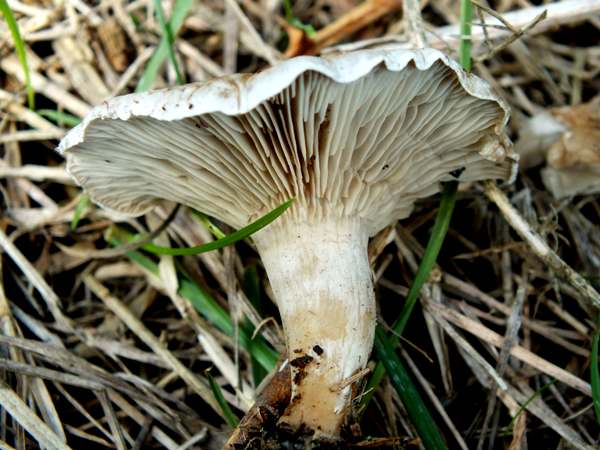
Identification
Often buried in grass and easily overlooked, this coastal mushroom is gregarious and, when you look closely at the cap, stem and gills, quite distinctive, but for confident identification it may be necessary check spore colour (pink, not white like many grassland funnel-sheped mushrooms) and to view and measure the spores.
.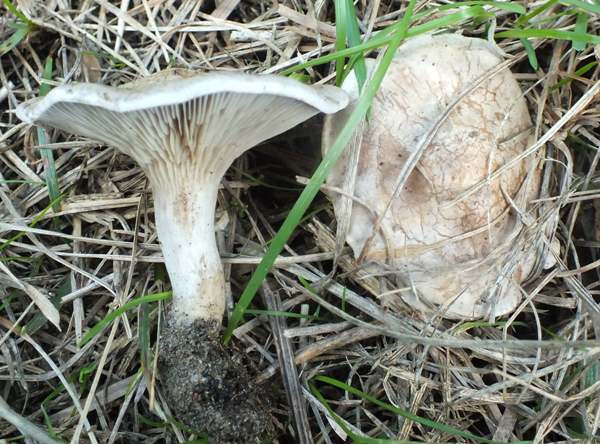
Distribution
This moderately salt-tolerant mushroom is an uncommon find in Britain and Ireland, although it is fairly common in vegetated coastal sand-dune systems. This species occurs also across much of mainland Europe. A very similar mushroom occurs in parts of North America and it is not clear whether it is co-specific with this European species.
Taxonomic history
When in 1821 Elias Magnus Fries described this mushroom he gave it the scientific name Agaricus popinalis. (In the early days of fungus taxonomy most of the gilled mushrooms were included initially in the genus Agaricus.) The scientific name Clitocella popinalis dates from a 2014 publication by American mycologists Kerri L. Kluting, Timothy J. Baroni and Sarah E. Bergemann, who circumscribed this new genus..
Synonyms of Clitocella popinalis include Agaricus popinalis Fr., Clitopilus popinalis (Fr.) P. Kumm., Paxillus popinalis (Fr.) Ricken., Clitocybe popinalis (Fr.) Bres., Rhodopaxillus popinalis (Fr.) Konrad & Maubl., and Rhodocybe popinalis (Fr.) Singer.
Etymology
The generic name clitocella comes from ancient Latin words Clito-, meaning sloping, and -cella, meaning storage space.
The specific epithet popinalis is a Latin adjective and means 'of or belonging to an alehouse.'
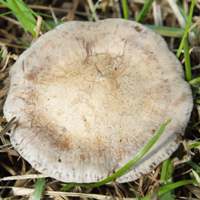 |
Cap
2 to 5 cm diameter; convex, rataining an inrolled margin as it flattens or becoming slightly centrally depressed, developing a wavy margin; dry; smooth; whitish to yellowish grey; often acquiring concentric wrinkles and cracks at maturity.
Cap turns red-brown with KOH.
|
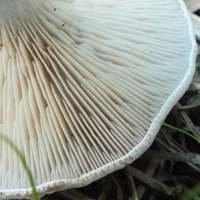 |
Gills
Decurrent, fairly crowded; often forked near stem; whitish to greyish buff when young, becoming brownish pink as the spores mature.
Hymenial pseudocystidia: absent. Clamps: absent. |
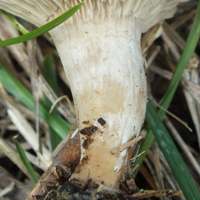 |
Stem
Cylindrical or slightly tapering towards base; 3 to 5cm long and 4 to 7mm diameter; white near the apex then slightly brownish and fibrous towards the base.
The flesh is white but turns grey when cut or bruised and exposed to air. |
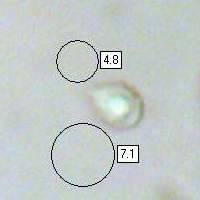 |
Spores
Isodiametrical (broadly ellipsoidal, angular), thin-walled with small irregular warts; 4-6 x 3-5μm.
Spore print
Pink. |
Odour/taste |
Mealy odour (like wet flour); mealy and slightly bitter taste. |
Habitat & Ecological role |
Saprobic, usually in groups, on sandy soil in coastal dune grassland. |
Season |
Fruiting late summer and autumn in Britain and Ireland. |
Similar species |
Entoloma clypeatum has a more domed cap and has much larger spores. |
Culinary Notes
Although reported to be edible, this is a rare find throughout most if not all of its range - sufficient reason, surely, for not collecting this species other than when necessary for research purposes.
Reference Sources
A New Abridgment of Ainsworth's Dictionary: English and Latin, by Robert Ainsworth (1846) U. Hunt & son.
Flora agaricina neerlandica : critical monographs on families of agarics and boleti occurring in the Netherlands / 1, A, General part. B, Special part : 'Entolomataceae' by y Machiel Evert Noordeloos et al. (1988)
Dictionary of the Fungi; Paul M. Kirk, Paul F. Cannon, David W. Minter and J. A. Stalpers; CABI, 2008
Taxonomic history and synonym information on these pages is drawn from many sources but in particular from the British Mycological Society's GB Checklist of Fungi.
Top of page...
Fascinated by Fungi. Back by popular demand, Pat O'Reilly's best-selling 450-page hardback book is available now. The latest second edition was republished with a sparkling new cover design in September 2022 by Coch-y-Bonddu Books. Full details and copies are available from the publisher's online bookshop...